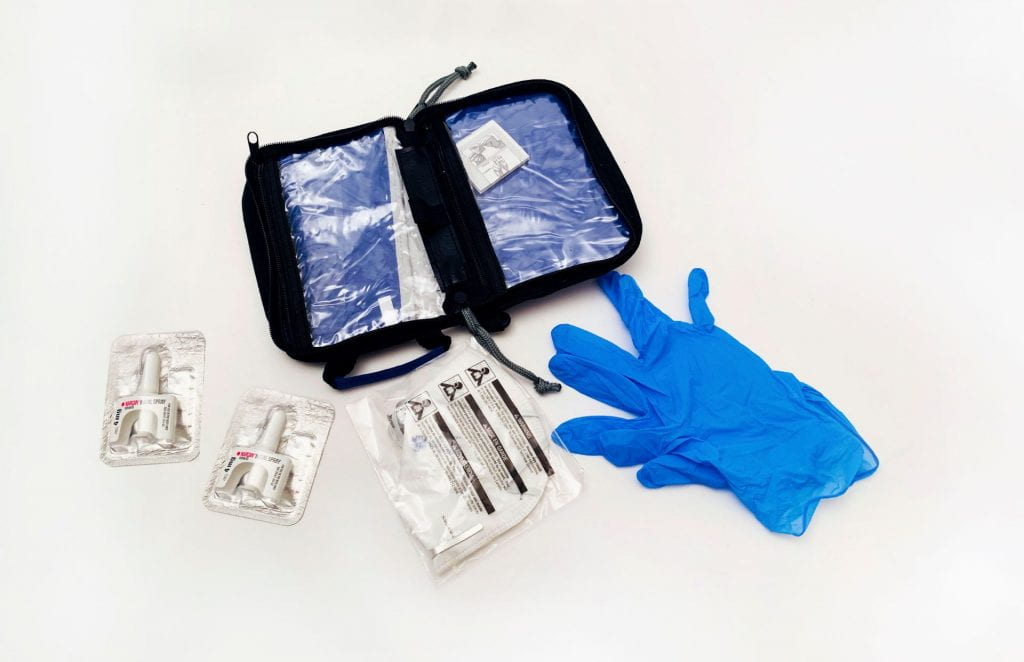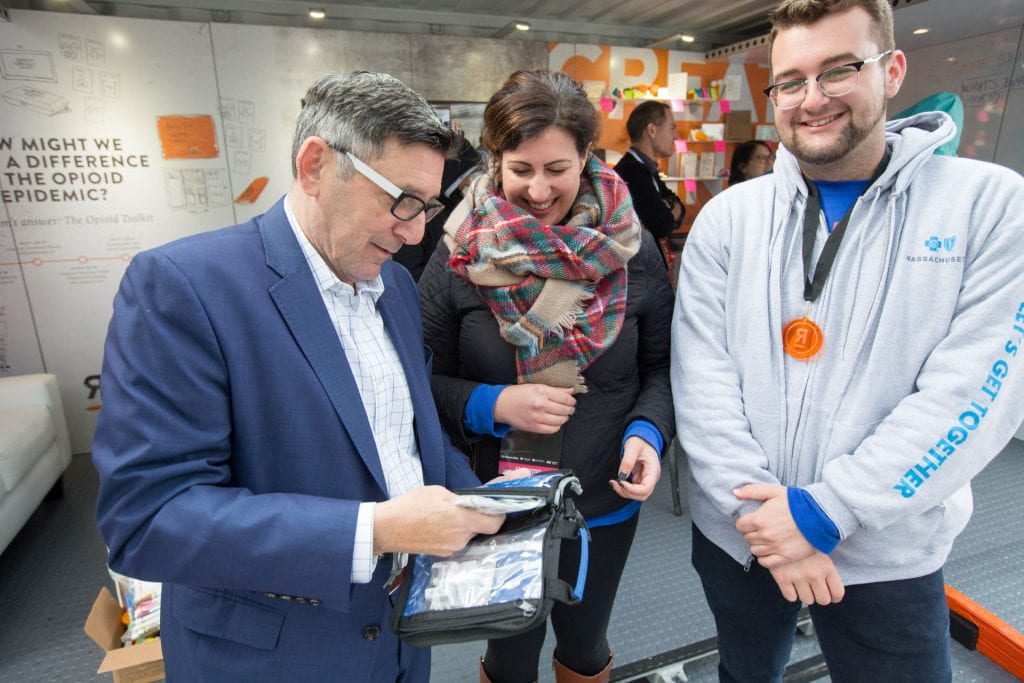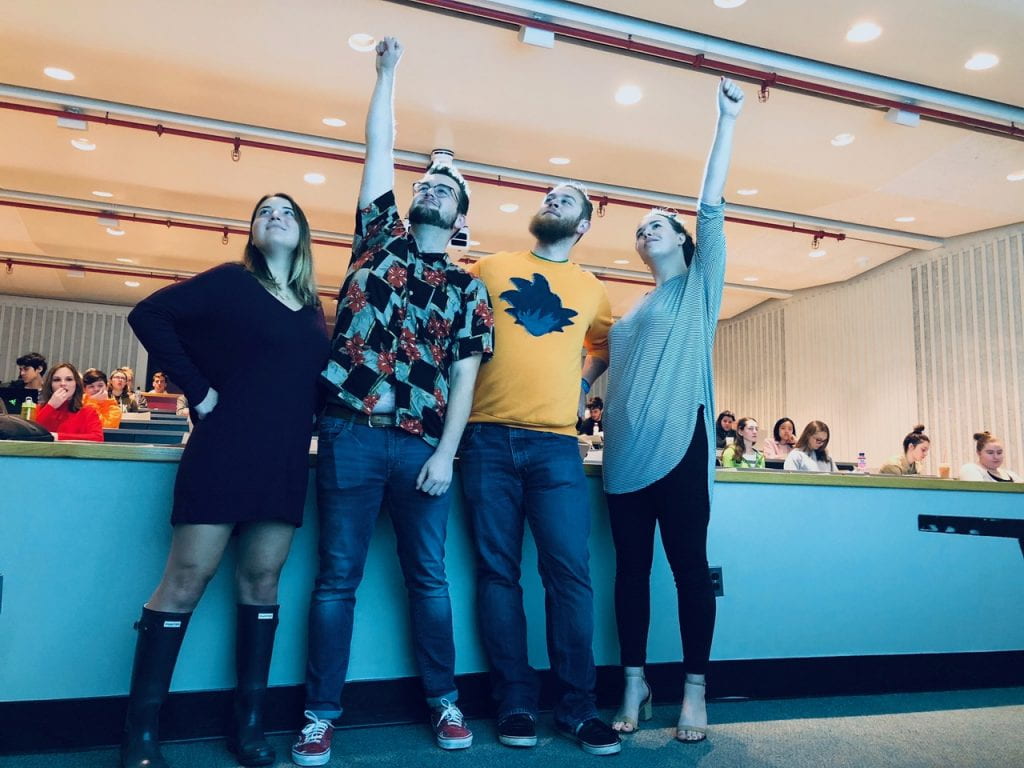By Bret Silverberg
ON A WEEKDAY DURING SPRING SEMESTER, a group of Wentworth students head to Boston’s Prudential Center. They’re not going to shop, dine, or work—not in the traditional sense anyway.
They’re going to class.
Specifically, they are heading to Industrial Design Studio. The course, which meets twice weekly for three-hour sessions and is offered to juniors and seniors, has been most-recently located at the headquarters of health insurer Blue Cross Blue Shield of Massachusetts, where Wentworth faculty member Matthew Templeton has spent the last three years as the organization’s senior director of innovation, strategy, and business solutions.

A Naloxone kit
Students of this class, which focuses on “design thinking,” get the unique opportunity to network with anyone from professional project managers to top executives at Blue Cross, while working on real projects to the benefit of the organization.
Templeton loosely refers to this as the “embedded classroom.” Here, he says, education goes from theoretical to experiential, from abstract to immersive.
“At Wentworth, all the professors are practitioners,” he says. “They actually have boots on the ground. As an educator here, nothing is just theory.”
Though this particular studio course does share some
of the attributes of a traditional cooperative working opportunity, it’s more of an off-site classroom in which students are encouraged not only to explore their creativity, but also to rub elbows with, ask questions of, and produce products alongside the people who do the work at the organization.
“We take the students really far really fast,” says Templeton, who has been teaching at Wentworth for 14 years.
“Our students learn creativity, but they have discipline, integrity. They’re really good on teams. I can teach anybody to be creative, but those other things are a lot harder to teach.” Students do have the opportunity to land a co-op with the organization through the studio course. This type of work-meets-class crossover played out in January 2018 when industrial design student Alex Connor, BIND ’19, then a junior, conceptualized, designed, and iterated an opioid overdose prevention toolkit through his work in the studio. He then chose to do his official co-op with Blue Cross and eventually took his product to market at a time when Massachusetts grapples with an opioid crisis. The state ranked in the top 10 for opioid-related deaths in 2016.
“This really jump-started my career,” says Connor, who graduates in August and is currently working part-time at Blue Cross after staying on following his co-op semester.
“I really care about helping people understand concepts through art and design, and health care is one of the hardest topics to understand. [This work] has taught me a lot.”
Spurred by Connor’s work at Wentworth, Blue Cross has disseminated about 800 kits to select employers with high-risk employee populations as part of a pilot program.
Prior students of the studio—alumni Sydney Meyers, BIND ’18, and Adam Supino, BIND ’18—took part in the development of a trivia-style game to enhance dialogue around health care and health insurance at home.

Alex Connor (right) presents his opioid overdose prevention kit, developed at Wentworth for Blue Cross Blue Shield of Massachusetts, at Hubweek 2018, an annual Boston-based innovation conference
Industry-Driven Classes
Real-world preparation continues to have an impact all around campus. Professor Jack Duggan, department chair of the Department of Civil Engineering, is creating a new elective class that will train students in hazardous material work. After hearing from industry partners like consulting firm GZA GeoEnvironmental that Wentworth graduates have all the tools except for that one, Duggan and others pivoted their class structure to change with industry demand.
Through the partnership, students will have the opportunity to complete eight hours of field work, which may be done at GZA headquarters in Norwood, Mass.
“This is changing the way that I would teach electives and other classes,” Duggan says.
Mark Bamforth, a member of Wentworth’s board of trustees, says Wentworth is well-positioned when it comes to getting students prepared for the real world due to the valuable “high-skill” work being accomplished in the classroom combined with the school-wide mandatory co-op program.
“A Wentworth student can have the incredible experience of going into a workplace where they have more knowledge of a software program than maybe someone working there,” says Bamforth.
Bamforth is the CEO of Brammer Bio, a viral vector contract development and manufacturing organization supporting cell and gene therapy companies, which was recently acquired by Thermo Fisher Scientific. He is also the parent of a Wentworth student.
“Clearly there are schools that are focused on academic excellence,” he says, “but academic excellence and practical application is a very powerful combination for students entering the workforce.”
Templeton says he thinks the embedded classroom concept is one-of-a-kind, outfitting students with real-world experience, and, ideally, arming companies with talent in a time where high-skill workers are in short supply. The synergy between the Wentworth students and Blue Cross has been totally natural.
But Templeton is quick to remind that the embedded classroom, with all of its access to offices, employees, and opportunity, is extraordinary.
On the last day of the summer semester, he took a group of juniors to lunch where high-ranking Blue Cross staffers joined.
“I said to the students, ‘You guys realize this isn’t a normal class, right?’” Templeton says. “The bar has been set kind of high.”

From left: Industrial Design students Kiera VanGulden ’19, Alex Connor ’19, Adam Supino ’18, and Sydney Meyers ’18 lead a design thinking course for sophomores during fall semester 2018.

